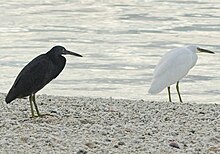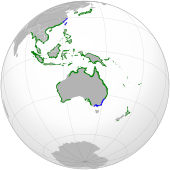Riffreher
| Riffreher | ||||||||||||
|---|---|---|---|---|---|---|---|---|---|---|---|---|

Reef Free Herons (dark color morphs of New Zealand) |
||||||||||||
| Systematics | ||||||||||||
|
||||||||||||
| Scientific name | ||||||||||||
| Egretta sacra | ||||||||||||
| ( Gmelin , 1789) |
The reef freon ( Egretta sacra ) is a bird in the heron family . A distinction is made between two color morphs. The distribution extends over the entire oriental and oceanic region from India and Southeast Asia to Japan, Australia, Tasmania, New Zealand and Polynesia.
description
This medium-sized heron reaches a length of 57 to 66 cm and a wingspan of 90 to 110 cm. Its weight is over 400 g. The legs are very short and yellowish. The plumage is slate gray. There is a narrow, white stripe on the throat and chin. During the breeding season, it has long decorative feathers on its neck and back. The beak is brown and the eyes are yellowish in color. The surrounding facial skin shows a greenish yellow tone.
The reef free herons have dimorphism , which means that there are two color variants. The proportion of light and dark morphs varies depending on the distribution area. The dark color morph occurs almost exclusively in New Zealand.
Habitat and way of life
The habitat of the reef freeher are coastal areas and estuaries. He prefers stony coastlines and also uses coral reefs. He also stays in the tidal zones of estuaries or uses mangrove-lined coastlines. It also occurs on sandy beaches when the surf is moderate there. It is observed relatively rarely in Germany. In New Zealand it is also found on city beaches and is relatively unafraid of pedestrians and road traffic.
The food of the reef free heron consists of fish, mollusks, crabs and other marine animals, which it prey on while crouching.
The reef freeher breeds all year round in colonies in the jungle, between palm trees and mangroves or in caves or old buildings. Two to three pale greenish blue eggs are laid in a nest of twigs and flowers. The breeding business is shared by females and males. The incubation period is up to 28 days. The boys are then looked after by their parents for about 5 weeks.
status
In Australia, the reef freeher has been a nature reserve since 1974. The IUCN classifies it as not at risk ( least concern ).
supporting documents
literature
- Bruce Campbell: The Great Bird Book. Eugen Ulmer Verlag, Stuttgart 1976.
- PJ Higgins (Eds.): Handbook of Australian, New Zealand & Antarctic Birds , Volume 1, Ratites to Ducks, Oxford University Press, Oxford 1990, ISBN 0-19-553068-3
Web links
- Matuku moana - The Reef heron (engl.)
- Egretta sacra in the endangered Red List species the IUCN 2008. Posted by: BirdLife International, 2008. Accessed January 31 of 2009.
- Videos, photos and sound recordings of Egretta sacra in the Internet Bird Collection

